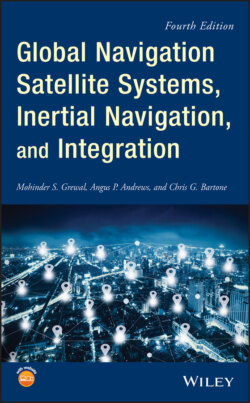Читать книгу Global Navigation Satellite Systems, Inertial Navigation, and Integration - Mohinder S. Grewal - Страница 102
3.4.2 Terrestrial Navigation Coordinates
ОглавлениеDescriptions of the major coordinates used in inertial navigation and GNSS/INS integration are described in Appendix B (www.wiley.com/go/grewal/gnss). These include coordinate systems used for representing the trajectories of GNSS satellites and user vehicles in the near‐Earth environment and for representing the attitudes of host vehicles relative to locally level coordinates, including the following:
1 Inertial coordinatesEarth‐centered inertial (ECI), with origin at the center of mass of the Earth and principal axes in the directions of the vernal equinox and the rotation axis of the Earth.Satellite orbital coordinates, used in GNSS ephemerides.
2 Earth‐fixed coordinatesEarth‐centered, Earth‐fixed (ECEF), with origin at the center of mass of the Earth and principal axes in the directions of the prime meridian at the equator and the rotation axis of the Earth.Geodetic coordinates based on a reference geoid. Geodetic latitude, defined as the angle between the equatorial plane and the local vertical, as illustrated in Figure 3.8. It can differ from geocentric latitude by as much as 12 arc minutes, equivalent to about 20 km of northing distance.Local tangent plane (LTP) coordinates, also called “locally level coordinates,” essentially representing the Earth as being locally flat. These coordinates are particularly useful from a human factors standpoint for representing the attitude of the host vehicle and for representing local directions. They includeEast–north–up (ENU), shown in Figure B.7;North–east–down (NED), which can be simpler to relate to vehicle coordinates; andAlpha wander or azimuth wander, rotated from ENU coordinates through an angle about the local vertical, as shown in Figure B.8.
3 Vehicle‐fixed coordinatesRoll–pitch–yaw (RPY), as shown in Figure B.9.
Transformations between these different coordinate systems are important for representing vehicle attitudes, for resolving inertial sensor outputs into inertial navigation coordinates, and for GNSS/INS integration. Methods used for representing and implementing coordinate transformations are also presented in Section B.4.
